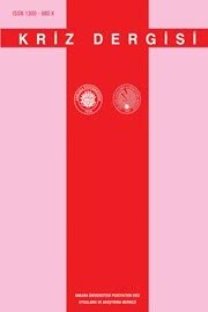Boşanmış Kadınların Yaşam Öyküleri ve Yoksullukla Baş Etme Biçimleri
Yoksulluğun kadınlar gibi dezavantajlı nüfus grupları üzerinde daha olumsuz etkiler yarattığı bilinen bir durumdur. Dahası, yoksulluk döngüsünü kırmak için başa çıkma stratejileri bulma görevini genellikle kadınlar üstlenmektedir. Kadınlar bir yandan yoksulluktan daha fazla etkilenirken diğer yandan yoksullukla baş eden birincil aktörler olarak ön plana çıkmaktadır. Bu çalışmanın amacı, boşanmış ve sosyal yardım alan yoksul kadınların yoksullukla ilişkili sorunlarının ve başa çıkma stratejilerinin belirlenmesidir. Araştırmada, Keçiören Sosyal Yardımlaşma ve Dayanışma Vakfından sosyal yardım alan ve boşanmış 10 kadının, derinlemesine görüşmeler yoluyla yaşam öyküleri alınmıştır. Araştırmada yarı yapılandırılmışla mücadele etmek için farklı yollar denedikleri görülmektedir
Anahtar Kelimeler:
Yoksulluk, boşanma, kadın, yaşam öyküsü
Life Stories of Divorced Women and Coping Strategies with Poverty
It is known that poverty has more negativeeffects on disadvantaged population groupssuch as women. Furthermore, women generallytake on responsibility to cope with poverty cycle.Women, in one hand, have been influencedmore negatively by poverty; on the other handthey are first actors to cope with poverty. The aim of this study is to determine theproblems and coping strategies of divorced andpoor women. The study is an applied field workwhich is designed as a qualitative research. Inthis study, life stories of 10 women who aredivorced and getting social assistance fromKeçiören Branch of Social Assistance andSolidarity Foundation are taken by in-depthinterviews. Semi-structured interview form hasbeen used in the study. In the interview form,questions included about the childhood, familylife, school life, working life, marriage historyand divorce process of women.It is understood that interviewed womenhave been grown up in poor families, married atearly years and many of them perceive marriageas a good way to get rid of poverty cycle andnegative living conditions. It is determined that,migration history accompany their marriage life,they generally hope to have better life conditionsby moving to metropolitan cities but they havestarted to lose their hopes due to their negativemarriage experience in the course of time.Women are generally subjects to torture by theirhusbands or his relatives. It is concluded thatthe problems have been effected on women’smental health. When examine the marriage
___
- Atkinson R (1998) The Life Story Interview: Qualitative Research Methods. XLIV.
- Balay Berrin (2002) "Bir Başka Yoksulluk Kadın Yoksulluğu Üzerine". Yoksulluk, Kent Yoksulluğu ve Planlama. 8 Kasım Dünya Şehircilik Günü 26. Kolokyumu, 6-8 Kasım, Ankara, 253-271.
- Berktay Fatma Gül (1998) "Cumhuriyetin 75 Yıllık Serüvenine Kadınlar Açısından Bakma". 75. Yılda Kadınlar ve Erkekler. Tarih Vakfı Yayınları, İstanbul, 1-13.
- Bianchi SM (1999) "Feminization and Juvenalization of Poverty: Trends, Relative Risks, Causes and Consequences". Annual Review of Sociology. 25: 307–333.
- Çamur Duyan Gülsüm ve Sema Buz (2003) "Türkiye’de Kadın Olgusu: Görüntü ve Gerçek". 8. Ulusal Sosyal Bilimler Kongresi, Ankara.
- Çamur Duyan Gülsüm (2006) Sosyal Hizmet Bakış Açısından Yoksul Kadınlar: Altındağ Örneği. Hacettepe Üniversitesi Sosyal Bilimler Ens. Sosyal Hizmet Anabilim Dalı Yayınlanmamış Doktora Tezi.
- Elmelecha Yuval ve Hsien-Hen Lub (2004) "Race, Ethnicity, and the Gender Poverty Gap". Social Science Research. 33: 158-182.
- Erman Tahire (1998) "Kadınların Bakış Açısından Köyden Kente Göç ve Kentteki Yaşam". 75. Yılda Kadınlar ve Erkekler. Tarih Vakfı Yayınları, İstanbul, 1998: 211-225.
- Hoffman S (1977) "Marital Instability and the Economic Status of Women". Demography. 14: 67–76.
- Holden K ve Smock P (1991) "The Economic Costs of Marital Dissolution: Why Do Women Bear a Disproportionate Cost?" Annual Review of Sociology. 17: 51–78.
- Kitson GC, Holmes WM (1992) Portrait of Divorce: Adjustment to Marital Breakdown. New York: Guilford.
- Seidman IE (1991) Interviewing as Qualitative Research. A Guide for Researchers in Education and the Social Sciences. New York.
- Simons, RL, Associates (1996) Understanding the Differences Between Divorced and Intact Families. Thousand Oaks, CA: Sage.
- Stirling K (1989) "Women who Remain Divorced: The Long Term Economic Consequences". Social Science Quarterly. 70: 549–561.
- Türkiye Nüfus ve Sağlık Araştırması (2003) H.Ü. Nüfus Etütleri Enstitüsü. Ankara.
- T.C Başbakanlık Devlet Planlama Teşkilatı, 2001 Yılı Programı. 2001.
- T.C Başbakanlık Devlet İstatistik Enstitüsü, Hanehalkı İşgücü Anketleri ve Türkiye’de İşgücü İsta- tistikleri, 2004.
- T.C Başbakanlık Devlet İstatistik Enstitüsü, Yoksulluk Araştırması, 2003.
- Wickrama, KAS, Lorenz FO, Wallace LE., Peiris L, Conger RD, Elder GH Jr (2001) "Family Influence on Physical Health During the Middle Years: The Case of the Onset of Hypertension". Journal of Marriage and the Family, 63: 527–539.
- Wickramaa KAS, Frederick O, Lorenz Rand D, Conger Glen H, Elder Jrc, W. Todd Abrahama, Shu- Ann Fanga (2006) "Changes in Family Financial Circumstances and The Physical Health of Married and Recently Divorced Mothers". Social Science and Medicine. 2006 Jan. 18: 1-14.
- http://www.aile.gov.tr/tr/?Sayfa=Gostergeler
- http://www.nvi.gov.tr/99,Evlilik_Ve_Bosanma_Is tatistikleri.html.
- ISSN: 1300-980X
- Başlangıç: 1992
- Yayıncı: Ankara Üniversitesi
